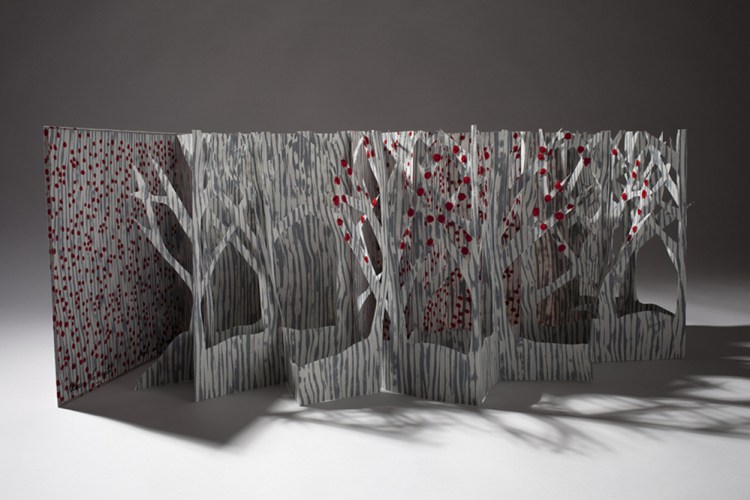“Focus: Printmaking” at Greenhut is a gallery-curated survey of regional printmakers. Portland features several active print shops and the outcome of these gathering points is a robust and ambitious community. That is apparent even from the first work visible in the exhibition, Jeff Woodbury’s “Guns Like Water,” a large 14-color screen print of what appears to be six flat-wood puzzle models for guns – M16s and Uzis.
Woodbury pulls out all the stops. The reference to the wooden models comes in the form of the wood-texturing of the negative space – the 200 or so (absent) gun piece shapes are in flat silhouette. “Guns Like Water” starts out feeling like a toy reference, as if the pieces could be popped out of the whole and assembled. But, it quickly slips through your fingers (like water) into philosophically murky turf. The idea of 3D printing insidiously slips in through this old toy model style and plays the concept of print multiplicity off the idea of weapons proliferation. As well, Woodbury plays the cartoon-like legibility of toys against a societal blight in a way that refuses to come into focus. By honing his wit on the dark ironies, he maintains an effective distance from partisan positioning. The result is that, while this work is entertaining and fun, it is still unsettled and unsettling.
Moreover, “Guns Like Water” is a technically masterful print. Yet Woodbury hides his accomplishment behind a veneer of simplicity by means of camouflage codes, like the cheesy wood grain and the seam that runs across the top third of the fake and real matrices. One of Woodbury’s best-played witticisms is that he created an actual eight-part print matrix (seven separate color screens and the white screen that was printed seven times) to create a simple image of a toy model matrix, making this one of the most labor-intensive and technically nuanced works in “Focus.”
And that is saying something. Scott Schnepf’s “Fish,” for example, is a cornucopian, Dutch-style still-life engraving of fish that, if it weren’t for the rubber bands on the lobsters, could be right out of Rembrandt’s day. Susan Amons’s “Night Heron with Lotus” is a dreamily complicated monoprint of a ghosted hunting bird, gnarled tree branches, lotus plants and frog prey all echoing the swollen red punctuation of the lotus bud about to bloom. Kristin Fitzpatrick’s 50-inch monotype, wax, pencil and beeswax “Reciprocal” feels like what you would get if Jackson Pollock used a tsunami to design a city. And Steve Burt’s deliriously detailed drypoint and gouache “Moonlit Church” is a churning, blue-night tree in the woods.
Many of the strongest works in “Focus,” like Woodbury’s standout “Guns,” however, do not loudly announce their efforts. Anna Hepler’s drypoint “Striped Form” could hardly feel more humble – like a ball of yarn drawn in pencil by a child – and yet it refuses to yield its delicious hold on your eyes. Its soft and stroke-warmed rhythms feel like petting a purring cat in your lap. Rebecca Goodale’s “Ilex laevigata” (smooth winterberry to most of us) is a standing fold-out book with branch spaces cut away and bouncy red berries sewn on one by one. Chris Beneman’s collographed monoprint hides its musicality behind a textured layer of engineering: We can easily miss the poetics under the immediacy of her straight-edge precision.
Beneman’s presence brings a blossoming sense of robust community. Not only is her work among the most notable, but she led the gallery’s curatorial effort and is herself a member of the Peregrine Press group.
“Focus: Printmaking” comes on the heels of a year that the Maine Curators’ Forum dedicated to photography. While I am not generally a fan of such arbitrary marketing-driven campaigns, Maine was overripe for a suite of photography shows and the Maine Photo Project was a success. But “Focus: Printmaking” struck me as a fresh reminder about standards and motivation.
The great message of the Maine Photo Project was that there is excellent photography in the state and that it is worth doing the heavy lifting to support and create a market for it. Printmaking already offers that model. It is not confused about what an edition is, artist proofs, where signatures go, etc. (Ask several photographers, “Are 8×10 prints in the same or a different edition than 16×20 prints of the same image?” and you will get widely varying answers.) And not only does printmaking have a long and established history of professional protocols, but it builds excellent communities around its technical needs. Several of Portland’s leading print communities are well-represented in “Focus: Printmaking,” including, among many of the other artists, Lisa Pixley, the founder of Pickwick Independent Press, and Peregrine Press co-presidents, Jeff Woodbury and Kate Cheney Chappell.
“Focus” has the pedagogical sweep of a curated museum show, but it feels a bit different. Instead of covering all of the bases – there is no etching in the show, for example – each of the included artists had to achieve the professional standards of the gallery. The outcome is subtle, but it works, not only for the public, but for the artists and the gallery as well. The works, after all, aren’t just for show, but for sale.
Freelance writer Daniel Kany is an art historian who lives in Cumberland. He can be contacted at:
dankany@gmail.com
Send questions/comments to the editors.




Success. Please wait for the page to reload. If the page does not reload within 5 seconds, please refresh the page.
Enter your email and password to access comments.
Hi, to comment on stories you must . This profile is in addition to your subscription and website login.
Already have a commenting profile? .
Invalid username/password.
Please check your email to confirm and complete your registration.
Only subscribers are eligible to post comments. Please subscribe or login first for digital access. Here’s why.
Use the form below to reset your password. When you've submitted your account email, we will send an email with a reset code.